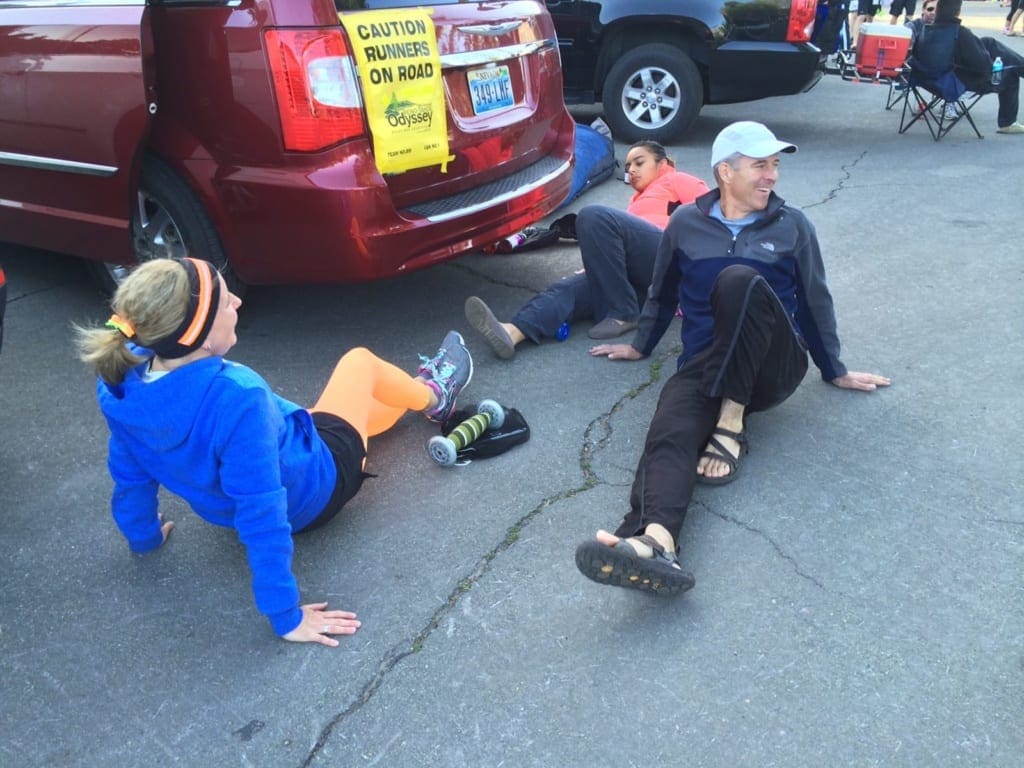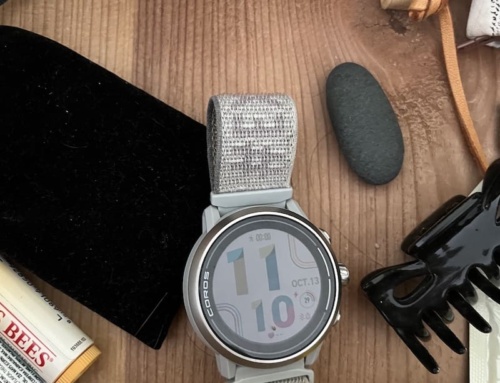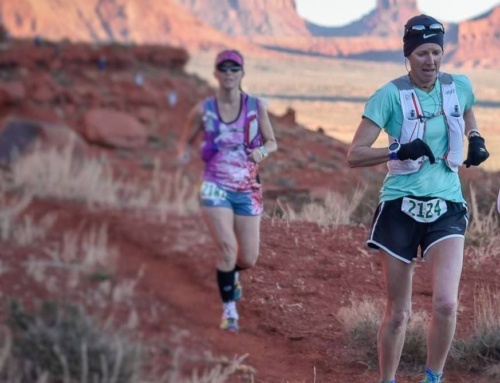Heidi Parker, a mother runner in Reno, Nevada, was not happy with her hamstrings. Or they weren’t happy with her. One or the other; either way, her angry lower body was the next perfect recipient for the AMR TriggerPoint Traveling Ultimate 6 Kit.
What is a hamstring strain? Well, the correct term is Angry Right Hamstring (ARH), as I affectionately called it these last six months or so. Backing up: the hamstring is three strings of muscles that run up the back of the leg that, as an article in Running Times says, “is responsible for propelling your body forward with every step…If you were a car, your quads would be the springs and your hamstrings would be the engine…the hamstring muscle complex has three basic roles with running: slowing the striding leg down as it approaches the ground; extending the hip and propulsion of the body forward; and assisting the calf muscle as it helps to move the knee.” A strain is a series of small tears to one or more of the muscles, which you feel everytime you make one of those motions.
On a scale of 1 (a hangnail) to 10 (hospitalization required), I would rate this injury as a: When I first felt my hamstrings bark, it felt like a 7 when I was running and a 2 when I was going about my day. But in March, I ran the Sacramento Shamrock’n Half, despite the fact that my hamstrings weren’t any better, and after I was finished I was in pain. Not I just ran 13.1 miles and my legs are sore pain, but I can barely walk pain. My post-race pain? A 9.
What causes a hamstring strain? They’re common in sprinters who stretch the muscle too fast or too far; for endurance runners, bursts of speed can bring on a strain, as can many other factors, including fatigue, poor form, tight hamstrings, really strong quads and really weak hamstrings. For more explanation, check out this link.
For me it was a combination of things. Like many runners, I automatically buy the next version of my favorite shoe and assume it’s going to be just like the previous version. I bought it online, so didn’t try it on.
I quickly learned that a small design tweak can make a big difference; one day, I was running errands in the old version and later headed out the door for a run in the same shoes. Halfway through my run, I realized that both my hamstring hurt substantially less and I hadn’t changed my shoes. Ding! Light bulb! My friendly Reno Running Company store fit me for the new and improved version of my favorite shoe, and the road to recovery began. It was a good reminder to buy shoes in person.
While I was playing shoe roulette, I also hadn’t been consistently running, so my mileage was random and fluctuated pretty wildly. I wasn’t following any kind of plan or the tried-and-true, don’t increase your mileage any more than 10% weekly. So I joined the AMR Prove It challenge to help me stay on track.
Lastly, I rarely stretch, roll, downward dog pose or whatever else runners are supposed to do. The roller we own collects dust in the corner and I never go to the yoga style “Flow” class offered by the women’s cross-training program I attend.
What a hamstring strain feels like: Pain in the back of the thigh and lower butt when walking, straightening the leg, bending over, or running. When I wasn’t running it felt like a toothache or itchy bug bite: I knew it was there but it was manageable. When I ran it would be ok for the first couple miles, then by the time I got to 3 or 4 miles, it loudly reminded me I probably shouldn’t be running!
You might have a hamstring strain if: Hamstrings are pretty vocal, so if you hear them, you might be on the lucky winner of a strain. The pain/discomfort is clear and targeted and um, loud. One way you know you have it is when you bend over to shave your legs, your outstretched hurt leg leg doesn’t want to be straight and you shave as fast as possible to make the discomfort stop. You also feel it if you put your opposite toe on the opposite heel to slip off your running shoes; the injured leg would much prefer you sit down, untie your shoes, and take them off with your hands. Sitting for long periods of time can get super uncomfortable as well.
What and how to roll: This was the biggest education for me. After receiving the Ultimate 6 Kit, I read through the handy guide. I read through it again. There is nothing here for hamstrings! I thought,” They must have sent me the wrong guide.” I asked Amanda, my contact at TriggerPoint if I was missing something. She explained that many strained muscles benefit from rolling/stretching the surrounding areas. This was a new concept for me, but once I tried the ones she suggested, I believed her. I was hooked.
I found the most success with the Piriformis manipulation; releasing the muscles in my butt in turn allowed my hamstring to relax. The Piriformis makes the hamstrings tight—tight in a bad way, not in a cute butt way.
That TriggerPoint striped massage ball is incredible! Sitting on it and slowly releasing the muscles had level of discomfort, but shouldn’t be painful; Amanda definitely emphasized the difference, and that knowledge helped get through the initial discomfort of the first few uses. (Here’s a TriggerPoint video that demonstrates how to release the piriformis.) Hitting my calf and the arches of my feet was also helpful; the body is a chain of muscles, and the hamstrings are attached, one way or another, to the entire chain of leg muscles.
I roller two to three times a week. Amanda suggested rolling before I worked out or ran, and then before bed. That seemed like a lot for me since I hadn’t rolled at all before. So I concentrated on rolling after long runs, and a couple evenings a week.
What else worked physically for me: Soaking in Dr. Teal’s Eucalyptus Epsom Bath Salts, walking, massage once a month, strength training, and rest. Riding my purple cruiser bike helped too. When it was at its worst, I used ice packs and ibuprofen.
How I coped mentally: I tried to keep my runs around 3 miles; I have a loop in my neighborhood that was perfect. This allowed me to keep running, but not at the level that was aggravating my hamstring. I followed the AMR Prove It plan, and especially paid attention to the increase in weekly mileage. I actually wrote the plan down in a Runner’s World training log my husband gave me so all I had to do each week was look at the plan. No guessing or overtraining.
How I’m going to avoid straining it again in the future:
Three important points for me:
1. Pay attention to my shoes. Styles change, our bodies change—and so does our stride.
2. Pay attention to my mileage. I’ve been running for 10 years, but I still need to make sure I’m not going too far, too fast. I joined the next AMR 13.FUN Challenge to help me with this.
3. Pay attention to my tight muscles. All those articles in running magazines about the importance of stretching, yoga classes, etc. are there for a reason. I’m going to do a better job of listening to them. also am finding time in my day to stretch – those 2 minutes spent brushing my teeth? Kick that leg up on top of the bathtub and stretch at the same time. We’re moms – we can use multitasking for ourselves too!
Since I’ve been following all of the above, I was able to run about 15 miles in the Reno Tahoe Odyssey Relay on May 30-31. My three legs were up and down hills; not only did I run a pace I was happy with, but I ran completely without pain. I also brought the Ultimate 6 Kit along in our relay van, and a couple of my teammates were spotted using it too.
If you’ve suffered from a hamstring strain, how did you recover? Any other tips or ideas to share?
We’ve covered IT Band Syndrome and Plantar Fasciitis and shin splits in previous episodes, but if you have another running injury that needs some TLC from the AMR Ultimate 6 Kit, email us at runmother [at] gmail [dot] com and we’ll see if we can get some relief sent your way.
Also, if you’ve got your eye on—or your muscles are longingly aching for—some TriggerPoint products, grab 20% off with code AMR20 at checkout on TriggerPoint.









I understand that pain. I have been having major piriformis muscle issues for awhile now. Seeing a Chiropractor recently has sorta helped. It also makes my hamstrings and calf muscles sore on my left side. I’ve had to majorly reduce my mileage. I hate it. Thank goodness I have my bike.
Wow! I have a very annoying a sometimes angry hamstring that I’ve been ignoring for over a year now. It is pain free when I run, but the second I stop, I feel it. It all started when I popped my hip out playing soccer with my son. It went right back in, and I talked with a physical therapist. I think my hamstring has since took the burden of the healing. Heidi is right, I need to start stretching and doing yoga more. All those other things that make you a stronger runner, because I am not getting any younger.
I realized that I wasn’t getting any younger either! I also didn’t realize how tight my muscles were/are and how paying attention to them is just as important as putting in the miles :)